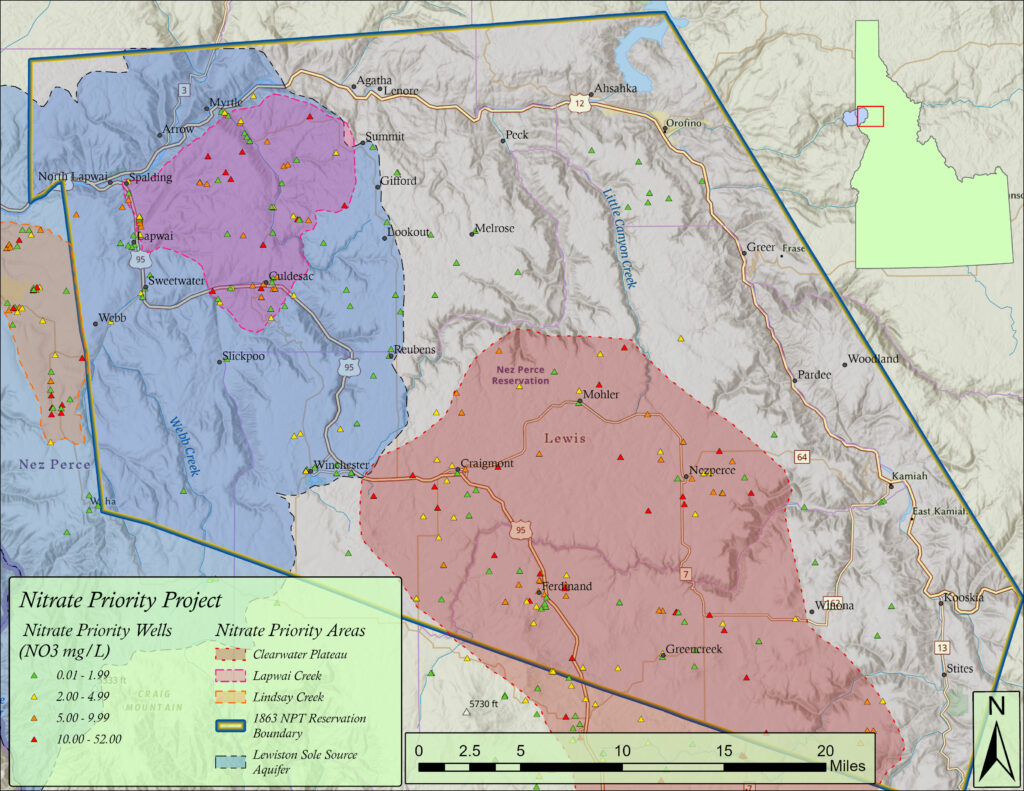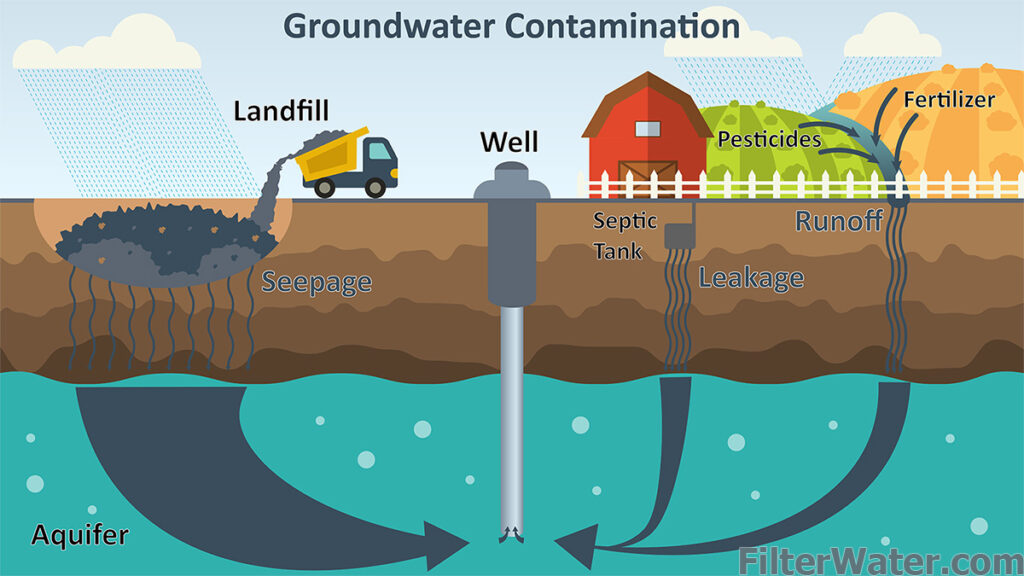Nitrate Priority Area Project
Nitrate Priority Area Project
Water Resources Division (“WRD”) was awarded an FY2024 Source Water Protection grant to understand avenues of groundwater contamination. Specifically, staff are inventorying springs and shallow groundwater wells on Tribal land that are used to supply drinking water to people and their livestock. Through this grant, WRD can provide limited water quality testing to interested spring and well users on Tribal land near a designated Nitrate Priority Area FREE OF CHARGE. This water quality testing includes testing for nitrates and bacteria (Escherichia coli, a type of bacteria commonly found in the intestines of people and animals).
Nitrate is a form of nitrogen, which is an element commonly found in foods and fertilizers to help plants grow. Unused nitrate easily dissolves in water and can pass through the soil to reach the groundwater. Septic and sewer systems, manure from animal feedlots, nitrogen-based fertilizers, and natural deposits all may lead to a build-up of nitrates in the soil. Seasonal runoff, irrigation, flooding, and precipitation can all facilitate the downward movement of nitrates into shallow groundwater. Additionally, these events may cause seasonal increases in nitrates in drinking water. Furthermore, nitrate can persist in groundwater for decades and accrue to high levels as more nitrogen is applied to the land each year.
In most cases, short-term exposure to high levels of nitrates does not cause any immediate health effects in humans or livestock. Sensitive groups, including infants, pregnant women, people in poor health, or the elderly, can be vulnerable to short-term nitrate exposure. Children younger than six months are extremely sensitive to high levels of nitrate, which may cause serious illness or even death. Symptoms of nitrate poisoning in infants include shortness of breath and blue-baby syndrome (“Methemoglobinemia”). These symptoms can occur rapidly over just a few days and if left untreated, may lead to the infant’s death. Do not boil drinking water to remove nitrate as this will concentrate nitrate levels.
For more information, please visit:
USGS National Water-Quality Assessment
What is a Nitrate Priority Area?
To be designated as a Nitrate Priority Area (“NPA”), at least 25% of sampled wells have nitrate levels at or above 5 milligrams per liter (“mg/L”). The boundaries of NPAs are heavily dependent on sampling locations but confirmed using more objective geostatistical methods. However, NPA boundaries should be considered identifications of general areas where nitrate levels are likely elevated. Nitrate levels may fluctuate seasonally or annually for any number of reasons, including flow direction, water level changes, seasonal land use practices, etc.
For more information, please view Idaho Department of Environmental Quality’s:

Where are Designated Nitrate Priority Areas?
There are three designated Nitrate Priority Areas in central Idaho:
- Clearwater Plateau
- Lapwai Creek
- Lindsay Creek
For more information and to see where you live in comparison to these NPAs, please visit:
Department of Environmental Quality’s 2020 Nitrate Priority Areas
What are Potential Pathways of Contamination?
The Lewiston Basin Aquifer was designated by the U.S. Environmental Protection Agency (“EPA”) as a Sole Source Aquifer in 1988 because it supplies at least 50% of the local population’s drinking water and there are no reasonably available alternative drinking water sources should this aquifer become contaminated. Therefore, it is critical that care is taken to keep this aquifer free of contaminants. Groundwater can become contaminated from industrial waste spills, leaking underground petroleum storage systems, sewage pipelines, or septic systems, poorly constructed or improperly abandoned wells, improperly disposed of chemicals like paints, disinfectants, oils, and garden chemicals, landfills, animal waste from feedlots, and application of pesticides, herbicides, and fertilizers. Because groundwater moves so slowly, these sources of contamination can build up in groundwater supplies.
For more information, please visit:
https://www.epa.gov/dwssa/map-sole-source-aquifer-locations
https://www.epa.gov/sites/default/files/2015-08/documents/mgwc-gwc1.pdf or
https://lcvaquifers-idaho.hub.arcgis.com/pages/aquifer-protection
Why is it Important to Test Spring and Well Water Quality Regularly?
People who receive their drinking water from public drinking water systems (i.e., municipality or other organization) have their drinking water regulated by the EPA, states, and tribes and enjoy routine water quality testing. Private well owners do not have their drinking water regulated. Therefore, it is the responsibility of the well owner to ensure their drinking water is safe by testing at least once per year.
For nitrates, the Idaho Groundwater Quality Standard and EPA drinking water standard for public water systems is 10 parts per million or 10 milligrams per liter (“mg/L”).
Please visit the Idaho Department of Environmental Quality’s webpage at https://www.deq.idaho.gov/water-quality/groundwater/groundwater-quality/ to learn more.
What Does Sampling Entail?
To streamline sampling efficiency due to limited personnel, WRD is partnering with Idaho Department of Environmental Quality to visit sites and collect water quality samples. Prior to sampling your well or spring, staff will contact you to obtain written permission to visit your property and access your well or spring. You do not need to be home when sampling occurs. On the permission form, you can list whether you want to be home when sampling occurs.
Once permission is obtained, staff will visit the site and run the water from the pipe located closest to the source (i.e., spring or well) for approximately 20 minutes or until water chemistry readings (i.e., dissolved oxygen, water temperature, and conductivity) stabilize. This ensures the collected samples are representative of groundwater conditions. Once water chemistry readings stabilize, staff will fill one 250-milliliter (“mL”) bottle and one 125-mL bottle of water to test for nitrates and bacteria, respectively.
Samples will be placed on ice and dropped off at a local laboratory (“lab”) daily. It will take approximately one month for the lab to process the samples and send staff the results. Once staff receive the water quality sampling results, we will send you a letter in the mail detailing those results.
How Do I Sign Up?
If you currently use springs or shallow groundwater wells on Tribal land to supply drinking water for yourself, your family, or your livestock and are interested in having your water quality tested, please contact the WRD’s Water Rights Administration Program at 208-843-7368. Funding is limited so water quality testing will be offered first come, first served by Nitrate Priority Area. Residents on Tribal land with drinking water provided by a spring or groundwater well located near the Clearwater Plateau Nitrate Priority Area will have their water tested in late April/early May 2024. Residents on Tribal land with drinking water provided by a spring or groundwater well located near the Lapwai or Lindsay Creek Nitrate Priority Areas will have their water tested in September/October 2024.

